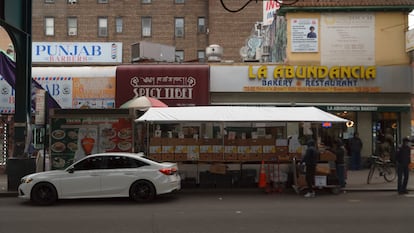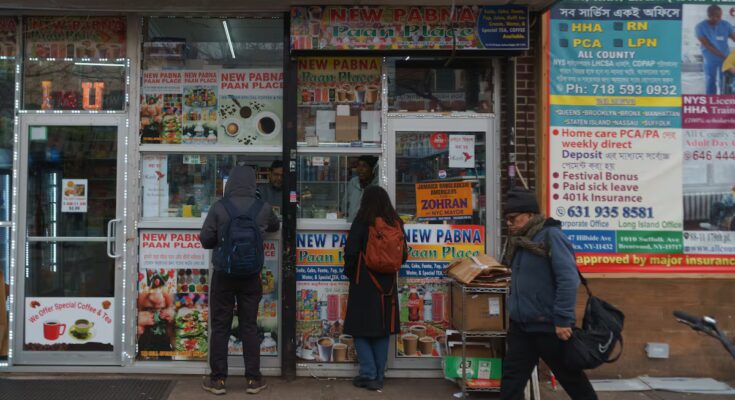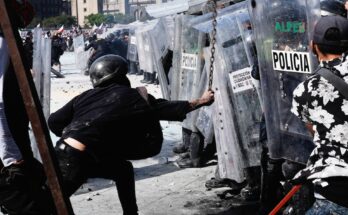A stretch of Roosevelt Avenue in Queens is known as the Avenue of 100 Tongues. On this street, which passes through two of the most diverse neighborhoods there are – Jackson Heights and Elmhurst – in the most diverse county in the United States, the accents and customs of more than one hundred countries meet. Here they eat Colombian arepas for breakfast and Indian curry for dinner, business signs begin in one language and end in another, and on a cold November morning the rhythm of a Mexican cumbia blares through the speaker of a food truck parked near the 74th Street subway stop with the conversation of a Nepalese couple strolling along the sidewalk.
A week has passed since Democrat Zohran Mamdani’s historic victory as mayor of New York. In the restaurants and shops surrounding the so-called Diversity Plaza, at the intersection of Roosevelt Avenue and Broadway, in the so-called “world district”, posters with the face of the mayor-elect still hang. From the window of one of those shops, next to a poster of “Bangladeshi Americans for Mamdani”, between a few words in Bengali and a bit of English, a seller recalls that Mamdani was here a few days before the November 4 elections.
It was the night of October 30th. The young socialist from the Democratic Party (34 years old) arrived at Diversity Plaza around midnight, after chatting with taxi drivers at La Guardia Airport and visiting health workers on night duty at a hospital in Elmhurst. He had dinner at one of his favorite kebab restaurants on the corner of the square before holding a press conference surrounded by his followers.
Mamdani has made areas like this one in Queens the centerpiece of his mayoral campaign. Not just because he resides in the District, but because he is aware that many of the issues that have dominated his career – diversity and migrant communities, the working class and “affordability” in a city with a skyrocketing cost of living – converge in neighborhoods like Jackson Heights, Elmhurst or Corona.
A few hours after the electoral victory, celebrated in Brooklyn, the politician was back in Queens. He met with members of his transition team beneath the Unisphere, a 100-foot-tall stainless steel globe built for the 1964 World’s Fair, which was held in the Corona neighborhood. Today the structure is one of the most recognizable symbols of Queens. Mamdani said he chose the location to hold his first news conference as mayor-elect because it symbolized his pride in the district. Then, he returned to Jackson Heights to have lunch at a Nepalese restaurant with New York Congresswoman Alexandria Ocasio-Cortez.
When he takes office on January 1, Mamdani, born in Uganda to Indian parents and a US citizen since 2018, will break more than one precedent. He will be the first mayor of New York to live in Queens, the first to have already represented the district in public office (he was a member of the State Assembly in Albany) and the first Muslim alderman in the history of the city. He will also be the first migrant to reach that position in nearly half a century.
For New York City Councilmember Shekar Krishnan, whose district includes three of the neighborhoods that Roosevelt Avenue runs through, it is impossible to understand Mamdani’s victory without first understanding the cultural richness of Queens. “And you can’t tell the story of Queens without telling the story of Jackson Heights,” he observes by phone from City Hall.
In New York, about 35% of its 8.5 million residents are migrants. In Queens, however, that percentage rises to almost 50% of a total of 2.3 million. And in neighborhoods like Jackson Heights, the immigrant population exceeds 60%. Mamdani won here, as well as in parts of Elmhurst and Corona, two other neighborhoods where more than half the population is made up of migrants.

According to the Alliance for Endangered Languages, more than 300 languages are spoken in the district, and a third of them coexist on Roosevelt Avenue. In a stretch of about twenty blocks between Jackson Heights, Elmhurst and Corona you can travel around the world without leaving New York: you can listen to Bengali, Nepali, Spanish, Punjabi, Tibetan, Urdu, Greek…
Krishnan assures us of the triumph of Mamdani, whom he has known for years: “(It was) a declaration of our values as a city, an affirmation of the importance of immigrant communities.” “His election illustrates how New Yorkers are united both in their desire for a more accessible city and in their desire for us to embrace and celebrate our diversity,” he says.
Krishnan was the first Indian-American elected to the City Council in New York’s history. It coincided with Mamdani in 2021 in a taxi drivers’ strike in which the now-elected mayor went on a 15-day hunger strike alongside hundreds of drivers protesting the debts they carried after being subjected to abusive credit practices to pay for their licenses. Both were arrested during the protests, which culminated in the city agreeing to a program that forgave millions of dollars in debt.
“I was drawn to that fight with Zohran precisely because we were fighting for our community,” Krishnan recalls. Many of these taxi drivers were migrants and Queens residents and joined Mamdani’s campaign four years later.
Trump’s birthplace
Now, as mayor of New York, Mamdani will position himself at the forefront of the Democratic resistance against Donald Trump. The Republican president has threatened to cut the city’s federal funding in response to the socialist’s victory and has considered sending National Guard troops, as he has already done in other Democratic cities such as Los Angeles, to enforce his immigration agenda. Mamdani, for his part, has made it clear that he will not be intimidated. In his victory speech on election night, he addressed the president directly, asked him to turn up the television volume to make sure he could hear him, and declared, “New York will continue to be a city of immigrants, built by immigrants and fueled by immigrants. And, starting tonight, led by an immigrant.”
Theirs will be the battle between the two queens, because Mamdani or Krishnan’s Queens, the migrant heart of the city, is also the birthplace of Donald Trump.
The president was born here. Its connection with the neighborhood, in fact, dates back to the beginning of the last century. His paternal grandparents, German immigrants, settled in Woodhaven, Queens, in the early 1900s. The president was born in the Jamaica neighborhood and grew up in the adjacent, affluent Jamaica Estates area, just over 10 kilometers but a world away from places like Jackson Heights or Elmhurst, which in those years were already known for their growing diversity.

In the 2024 presidential election, the GOP won significant support in both neighborhoods, as well as other areas of Queens with high migrant populations. Although the Democratic nominee, Kamala Harris, won New York State, she did so by a significantly smaller margin than Joe Biden won in 2020. In Elmhurst and Corona, Democratic support then dropped by 40%.
A year later, the vast majority of those same areas voted overwhelmingly for Mamdani. Although independent candidate and former New York governor Andrew Cuomo – whom the president endorsed just days before the vote – generally performed better among Trump voters, Mamdani managed to win back many immigrant-majority areas in Queens.
For Jason Antos, district historian, it’s not a difficult paradox to understand. “It’s very Queens,” he says. The director of the Corona-based Queens Historical Society argues that “many of the reasons people voted for Trump are the same reasons they voted for Mamdani,” starting with the high cost of living.
Antos explains that the district has always been a destination for migrants, since colonial times, when Europeans of various nationalities arrived attracted by the cheap land, also ideal for agriculture. Today, the diversity of the borough, in which “every town, even the smallest, is represented to some extent,” is due in part to the fact that it has continued for years to be a more affordable place to live than Manhattan or Brooklyn. Many migrant communities displaced by the city’s gentrification have ended up in neighborhoods like Jackson Heights.
It is a reality that, however, has been changing “in the last 20 years”, according to the historian. Rents and the cost of living have risen steadily in Queens, as in the rest of New York City. This issue was a focus of both Trump’s campaign in 2024 and Mamdani’s campaign in 2025. And it was also the key issue in the victories of both.
State Rep. Jessica González-Rojas, whose district includes Jackson Heights, says Mamdani won in these immigrant-majority areas who supported Trump because he understood voters’ concerns. “Zohran really listened to the community, especially after the 2024 election. What he heard from them was that they were fed up with the politics of the past and were looking for something different. And the issue of affordability was something that really resonated,” he notes by phone from Albany.
González-Rojas made it to the State Assembly in 2021 alongside Mamdani, being the first Latina, of Puerto Rican and Paraguayan descent, to be voted in to represent her district. He has known the newly elected mayor for years and supported his candidacy for the city council. He is confident that Mamdani’s government will be a government that reflects the contradictions of neighborhoods like Jackson Heights, which ultimately can also be seen as a mirror of the United States: a country increasingly of migrant origin, which struggles to make ends meet and seeks an alternative to the “old politics”.

Back in Diversity Square, from his shop window, the Bangladeshi seller smilingly says that he and his son voted for Mamdani. The reason? “Because we need a change,” he manages to answer.


